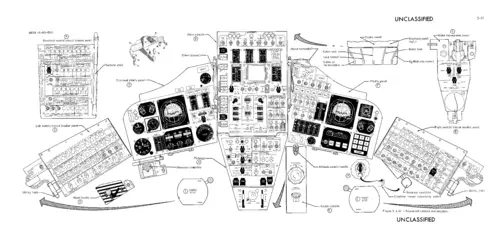The Gemini Guidance Computer (sometimes Gemini Spacecraft On-Board Computer (OBC)) was a digital, serial computer designed for Project Gemini, America's second man-in-space effort.[1] The computer, which facilitated the control of mission maneuvers, was designed by the IBM Federal Systems Division.[2]
History[edit]
Project Mercury was America's first man-in-space effort. Due to its simplicity and size, however, it did not have any independent maneuvering capability. The re-entry retrofire times and firing attitude were calculated by computing center on the ground and were transmitted in real-time to the spacecraft. Because of that the Mercury spacecraft did not require a main computer.
The Gemini spacecraft was designed to be an enlarged Mercury, performing the same general objectives. One of the largest changes to the craft was the addition of a second crew member (gemini in latin means "twin"). Another change is the orbital maneuvering system which was attached to the rear of the main cabin which made it possible to practice rendezvous techniques.
The Gemini Guidance Computer was added to the craft to fulfill the new requirements for the spacecraft which included added accuracy to re-entry and automate preflight checkout functions. The computer was also required for many of the rendezvous operations since the ground tracking network could not cover all possible orbital paths.
Functionality[edit]
The Gemini Guidance Computer was responsible for the following functions:[2][1]
- Ascent - serves as a backup guidance system. The switchover is manually controlled by the astronauts
- Orbital flight - provides a navigation capability to the astronauts to determine the time of retrofire and to select the landing site for safe reentry in the case of an emergency. (on extended missions ground data may become unavailable when ground data network rotates out of the orbital plane.)
- Rendezvous - serves as primary reference by providing guidance information to the astronauts. The orbit parameters are determined by the ground tracking which are then sent to the spacecraft; the guidance computer was responsible for processing the information along with sensed spacecraft attitude. The information was presented to the astronauts in terms of spacecraft coordinates.
- Reentry - feeds commands directly to the reentry control system for automatic reentry or provides the guidance information to the astronauts a manual reentry.
Specs[edit]
- The computer, which was very similar to the Saturn Launch Vehicle Digital Computer, weighted 58.98 pounds (26.75 kg) and was powered by a 28V DC. During a short power outage it could be powered by the Auxiliary Computer Power Unit (ACPU)
- 39-bit words memory, each composed of three 13-bit "syllables"
- ferrite core memory of 4096 words[3]
- Two's complement integer arithmetic
- 7.143 kilohertz clock (140 μs per instruction); all instructions took a single cycle except for multiplication and division
References[edit]
- ↑ 1.0 1.1 McDonnell Corporation, NASA Project Gemini Familiarization Manual, 1965, vol. 2, pp. 8.7,8.45.
- ↑ 2.0 2.1 8. J. C. Hundley and R. A. Watson, "A Digital Computer in Orbital Flight," TR 63-825-892, IBM Federal Systems Division, Owego, New York, October 1964.
- ↑ Computers in Spaceflight: The NASA Experience, chapter one

